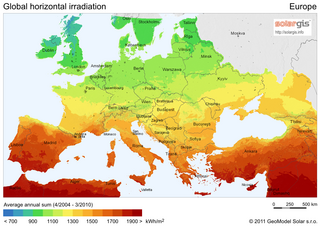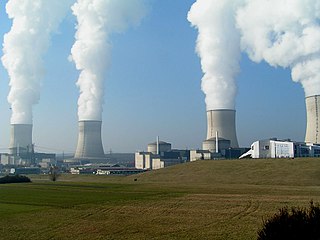
India is the third largest producer of electricity in the world. The national electric grid in India has an installed capacity of 388.134 GW as of 31 August 2021. Renewable power plants, which also include large hydroelectric plants, constitute 37% of India's total installed capacity. During the fiscal year (FY) 2019-20, the gross electricity generated by utilities in India was 1,383.5 TWh and the total electricity generation in the country was 1,598 TWh. The gross electricity consumption in FY2019 was 1,208 kWh per capita. In FY2015, electric energy consumption in agriculture was recorded as being the highest (17.89%) worldwide. The per capita electricity consumption is low compared to most other countries despite India having a low electricity tariff.

Renewable energy plays an important and growing role in the energy system of the European Union. The share of energy from renewable sources in gross final consumption of energy was 18% in 2018. This is double the share in 2004 with 8.5%. The Europe 2020 strategy includes a target of reaching 20% of gross final energy consumption from renewable sources by 2020, and at least 32% by 2030. These figures are based on energy use in all its forms across all three main sectors, the heating and cooling sector, the electricity sector and the transport sector.

Energy in France is generated from 5 primary sources: coal, natural gas, liquid fuels, nuclear power, and renewables. In 2020, nuclear power made up the largest potion of electricity generation, at around 78%. Renewables accounted for 19.1% of energy consumption. France has the largest share of nuclear electricity in the world. The country is also among the world's biggest net exporters of electricity. The country is increasingly investing in renewable energy and has set a target of 32% by 2030.

Spain has set the target of generating 20% of all its energy needs from renewable energy sources by 2020 and an additional 0.8% may be available for other EU countries under the cooperation mechanism bringing the total to 20.8%. By the end of 2014 Spain had reached a level of 16.2% of all its energy needs from renewable energy sources.

Solar power in the European Union consists of photovoltaics (PV) and solar thermal energy.
The largely government owned electricity sector in Haiti referred to as Électricité d'Haïti (ED'H for "Haiti Electric Utility", faced a deep crisis characterized by dramatic shortages and the lowest coverage of electricity in the Western Hemisphere in 2006. with only about 38.5% of the population having regular access to electricity. In addition, Haiti's large share of thermal generation makes the country especially vulnerable to rising and unstable oil prices.
Morocco's energy policy is set independently by two agencies of the government: the Office of Hydrocarbons and Mining (ONHYM)which sets domestic oil policy, and the Office National de l'Electricité (ONE), which sets policy with regard to electricity. The two major weaknesses of the energy policy of Morocco are the lack of coordination between these two agencies and the lack of development of domestic energy sources.
The Democratic Republic of the Congo was a net energy exporter in 2008. Most energy was consumed domestically in 2008. According to the IEA statistics the energy export was in 2008 small and less than from the Republic of Congo. 2010 population figures were 3.8 million for the RC compared to CDR 67.8 Million.

EDF Renewables is a wholly owned subsidiary of the French utility EDF Group, specializing in renewable energy production. As an integrated operator, the Group develops and finances the construction of renewable energy facilities, and manages operations and maintenance for its own account and for third parties.

Energy in Malta describes energy production, consumption and import in Malta. Malta has no domestic resource of fossil fuels and no gas distribution network, and relies overwhelmingly on imports of fossil fuels and electricity to cover its energy needs. Since 2015, the Malta–Sicily interconnector allows Malta to be connected to the European power grid and import a significant share of its electricity.

The electricity sector in France is dominated by its nuclear power, which accounted for 71.7% of total production in 2018, while renewables and fossil fuels accounted for 21.3% and 7.1%, respectively. France has the largest share of nuclear electricity in the world, and together with renewable energy supplies, this has helped its grid achieve very low carbon intensity.

The electricity sector in Switzerland relies mainly on hydroelectricity, since the Alps cover almost two-thirds of the country's land mass, providing many large mountain lakes and artificial reservoirs suited for hydro power. In addition, the water masses drained from the Swiss Alps are intensively used by run-of-the-river hydroelectricity (ROR). With 9,052 kWh per person in 2008, the country's electricity consumption is relatively high and was 22% above the European Union's average.
The France National Renewable Energy Action Plan is the National Renewable Energy Action Plan (NREAP) for France. The plan was commissioned by the Directive 2009/28/EC which required Member States of the European Union to notify the European Commission with a road map. The report describes how France planned to achieve its legally binding target of a 23% share of energy from renewable sources in gross final consumption of energy by 2020.

During the first decade of the new Millennium Italy was the third country after Germany and Spain to experience an unprecedented boom in solar installations after actively promoting solar power through government incentives. In July 2005 the country launched its first "Conto Energia" programme supporting the development of renewable power. Growth in solar installations picked up immediately but it was the years 2009-2013 that saw a boom in installed photovoltaic (PV) nameplate capacity, increasing nearly 15-fold, and 2012's year-end capacity of over 16 GW ranked second in the world after Germany, ahead of the other leading contenders, China, Japan and the United States at that time.
Renewable energy in the Czech Republic describes the renewable energy related development in the Energy in the Czech Republic.
Three primary energy sources make up the energy mix in Guinea: fossil biomass, oil and hydropower. Biomass makes the largest contribution in primary energy consumption. It is locally produced, while Guinea imports all the petroleum products it needs. The potential for hydroelectric power generation is high, but largely untapped. Electricity is not available to a high percentage of Guineans, especially in rural areas, and service is intermittent, even in the capital city of Conakry.
Under its commitment to the EU renewable energy directive of 2009, France has a target of producing 23% of its total energy needs from renewable energy by 2020. This figure breaks down to renewable energy providing 33% of energy used in the heating and cooling sector, 27% of the electricity sector and 10.5% in the transport sector. By the end of 2014, 14.3% of France's total energy requirements came from renewable energy, a rise from 9.6% in 2005.
Renewable energy in Greece accounted for 8% of the country's total energy consumption in 2008. 12% of Greece's electricity comes from hydroelectric power plants.

In Ukraine, the share of renewables within the total energy mix is still very small, but is growing fast. Total installed capacity of renewable energy installations more than doubled in 2011 and as of 2012 stands at 397 MW. In 2011, several large solar power stations were opened in Ukraine, among them Europe's largest solar park in Perovo, (Crimea). Ukrainian State Agency for Energy Efficiency and Conservation forecasts that combined installed capacity of wind and solar power plants in Ukraine could increase by another 600 MW in 2012. According to Macquarie Research, by 2016 Ukraine will construct and commission new solar power stations with a total capacity of 1.8 GW, almost equivalent to the capacity of two nuclear reactors.
Eranove is a French company active in the management of public services and in the production of electricity and drinking water in Africa. The company was formerly known as Finagestion.











